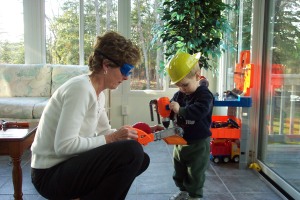Posture is always an interesting topic. As adults we are often trying to improve our posture because we have started discovering that poor posture can cause other problems like pain. These are things we don’t think of when we are younger and don’t always think about for our kids. Posture is something that can and should be worked on from when kids are little so that they can hopefully avoid long term problems as they get older. I have to thank one of our readers for coming up with this idea!
Here are some tips and ideas for exercises/playing that can also work on posture:
- Make sure kids hamstrings stay flexible. Its a lot easier to keep them flexible than to stretch them later. When hamstrings are tight it can tip our pelvis backwards so that it flattens our low back spine. To help with keeping hamstrings flexible have kids avoid w-sitting and long periods of kneeling as these will both shorten the hamstrings. They should sit in a variety of positions such as ‘criss cross’ or with their legs straight out in front of them. Here are some different sitting positions.
- Core strength is really important. Some of my favorite ways to improve core strength for kids other than having them do sit ups are:
- Lots and lots of climbing. Since its getting nicer out this should be easier because parks are lots of fun. The more unstable the climbing surface the more they will have to work their stabilizers and abdominals. I love climbing nets or climbing domes. Even ladders work well for this.
- Animal walks are a lot of fun and really challenge the core. Some of our favorites are bear walking (hands and feet) or crab walking or dog/cat walking (straight crawling). You can have animal parades or animal races. You can change the terrain by going over uneven surfaces such as cushions or you can go up and down hills. You can make animal obstacle courses where they have to be the animal and go around cones, over obstacles and through tunnels.
- Use a therapy ball. Have your kids sit on it and move it around in all directions with fast and slow motions. Or have them bounce on it. Try to give as little stabilization as possible (try for just the legs) and make sure they aren’t using their hands to hold on. If you can get them to engage their hands in play such as clapping or touching their head or reaching to the sky it automatically encourages more upright posture. I will also have kids reach for items such as bean bags and then throw them for a target while sitting on the ball.
- Try sitting on an unstable surface. There are wedges or core discs that are out there that can provide the ability to wiggle while sitting and allow kids to keep their core active and engaged. You need to try it out though because sometimes it can be too challenging and they will just sink into a slumped posture. Also if you can make a sitting surface a little higher than normal so their feet still hit the ground it can encourage an upright posture more than sitting at 90/90. Or if you have a therapy ball that they can sit on with their feet on the ground while watching tv or doing other things it really works to keep the core active. You have to make sure that they are safe while doing this though.
- Swinging at the park especially when they are self propelling naturally engages the postural muscles such as the scapular retractors and the abs. In addition they get some great vestibular input.
- Bike riding is really fun and great for core strength and endurance. If you really want to get the core working ride up slight inclines and hills, they will have to use their arms and abs to generate power from their legs.
- Reaching in sitting will also encourage upright posture. Have them sit in a variety of positions or on a variety of surfaces and play games where you make them reach up and in front or to the side. Watch their posture to make sure they are engaging their core muscles.
I probably have a ton of other ideas but this is a start. What are some of your favorite ‘exercises’ for encouraging improved posture with kids?
















